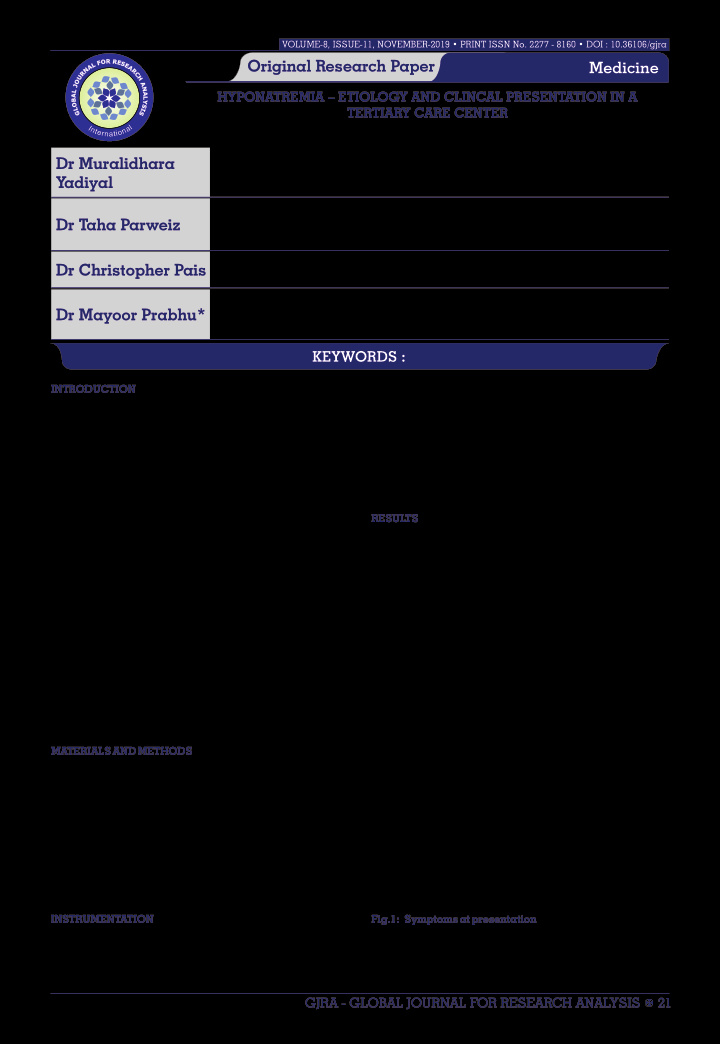



INTRODUCTION asymptomatic patients was 109. Among those who were Fig.1: Symptoms at presentation hyponatremia. had isotonic hyponatremia, 15 patients had hypertonic Hypotonic hyponatremia was seen in 68 patients, 17 patients patients had hiccups. anorexia, 5% patients had seizure, 2 % patients had coma, 1% lethargy, 19% had disorientation, 19% had vomiting, 12% had them had a combination of symptoms. About 40% had symptomatic (symptoms pertaining to hyponatremia) most of hyponatremia. The lowest serum sodium amongst Hypertension, 12 patients had Diabetes Mellitus, 6 patients The total of 30% was asymptomatic with documented 70(28%).There were more males than females in the study. maximum numbers of patients were in the age group of 61- Mangalore between October 2012 and April 2014. The hyponatremia to hospitals under Kasturba Medical College, A total of 100 patients were studied who were admitted with RESULTS structured Proforma. hyponatremia. All data thus obtained was entered in a etiology was determined and evaluated in different types of Pre - existing illness: In our study, 14 patients had had Chronic kidney disease. Ten patients had history of Hyponatremia is the most common electrolyte abnormality in Medicine 576104.*Corresponding Author Mangalore. Manipal Academy of Higher Education, Manipal, Karnataka- Assistant Professor, Department of Nephrology. Kasturba Medical College, Dr Mayoor Prabhu* Manipal Academy Of Higher Education, Manipal, Karnataka- 576104 576104. Mangalore. Manipal Academy Of Higher Education, Manipal, Karnataka- Post Graduate, Department Of Medicine. Kasturba Medical College, Dr Taha Parweiz KEYWORDS : GJRA - GLOBAL JOURNAL FOR RESEARCH ANALYSIS Tuberculosis, 11 patients had Retroviral disease. X 21 576104. Mangalore. Manipal Academy Of Higher Education, Manipal, Karnataka- Associate Professor, Department Of Medicine. Kasturba Medical College, Yadiyal Dr Muralidhara Original Research Paper TERTIARY CARE CENTER HYPONATREMIA – ETIOLOGY AND CLINCAL PRESENTATION IN A hypovolemic hypoosmolar. Following this categorization, the euvolemic hypoosmolar, hypervolemia hypoosmolar, and investigations, the type of hyponatremia was determined as .3 have either non-specic symptoms or symptoms due to seizures and coma. Most of the patients with hyponatremia patient to patient, from being asymptomatic, to ones having The clinical presentation has a wide spectrum and varies from dened as serum sodium <134 mEq/L. 4 admitted to an intensive care unit (ICU) had hyponatremia DeVita et al found that approximately 25% to 30% of patients in 30% to 40% of patients with a serum sodium of <135 mEq/L Hyponatremia is common in hospitalized patients, occurring mild and asymptomatic, hyponatremia is important clinically relative excess of total body water to sodium. 2 1, serum sodium concentration < 135 mEq/L, and it represents a Hyponatremia, or low blood sodium, is frequently dened as demyelination with life-threatening consequences. Inadequate or improper treatment may lead to brain edema or according to the timing of onset and etiology of the disorder. intensive care setting. Treatment varies signicantly hospitalized patients and is frequently encountered in the underlying system involved. Although majority of cases are because Acute severe hyponatremia can cause substantial osmolality, serum sodium, and urine sodium. Based on the morbidity and mortality. The aim of this study is to evaluate the function tests, renal function tests, serum osmolality, urine including, complete blood count, random blood sugar, liver clinical signs. The patients underwent the investigations were subjected to a physical examination for evaluating the with presenting complaints was noted. Further, these patients from the patients. A history of other comorbid conditions along Demographic data, including age and sex, were obtained INSTRUMENTATION was obtained before data collection. purpose of the study. Written consent from all the participants Institutional Ethical Committee and after explaining the proteinemia. Ethical clearance was obtained from the comprised of cases with hyperglycemia, hyperlipidemia, and the MICU were included in the study. The exclusion criteria moderate-to-severe hyponatremia (≤125 mmol/L) admitted to from October 2012 to April 2014. Patients aged ≥18 years with hyponatremia admitted under the Department of Medicine included 100 adult patients with moderate-to-severe The present 1-year cross-sectional observational study MATERIALS AND METHODS admitted a tertiary care hospital. clinical features and etiology of hyponatremia in patients VOLUME-8, ISSUE-11, NOVEMBER-2019 • PRINT ISSN No. 2277 - 8160 • DOI : 10.36106/gjra Dr Christopher Pais Professor, Department Of Medicine. Kasturba Medical College, Mangalore.
Recommend
More recommend